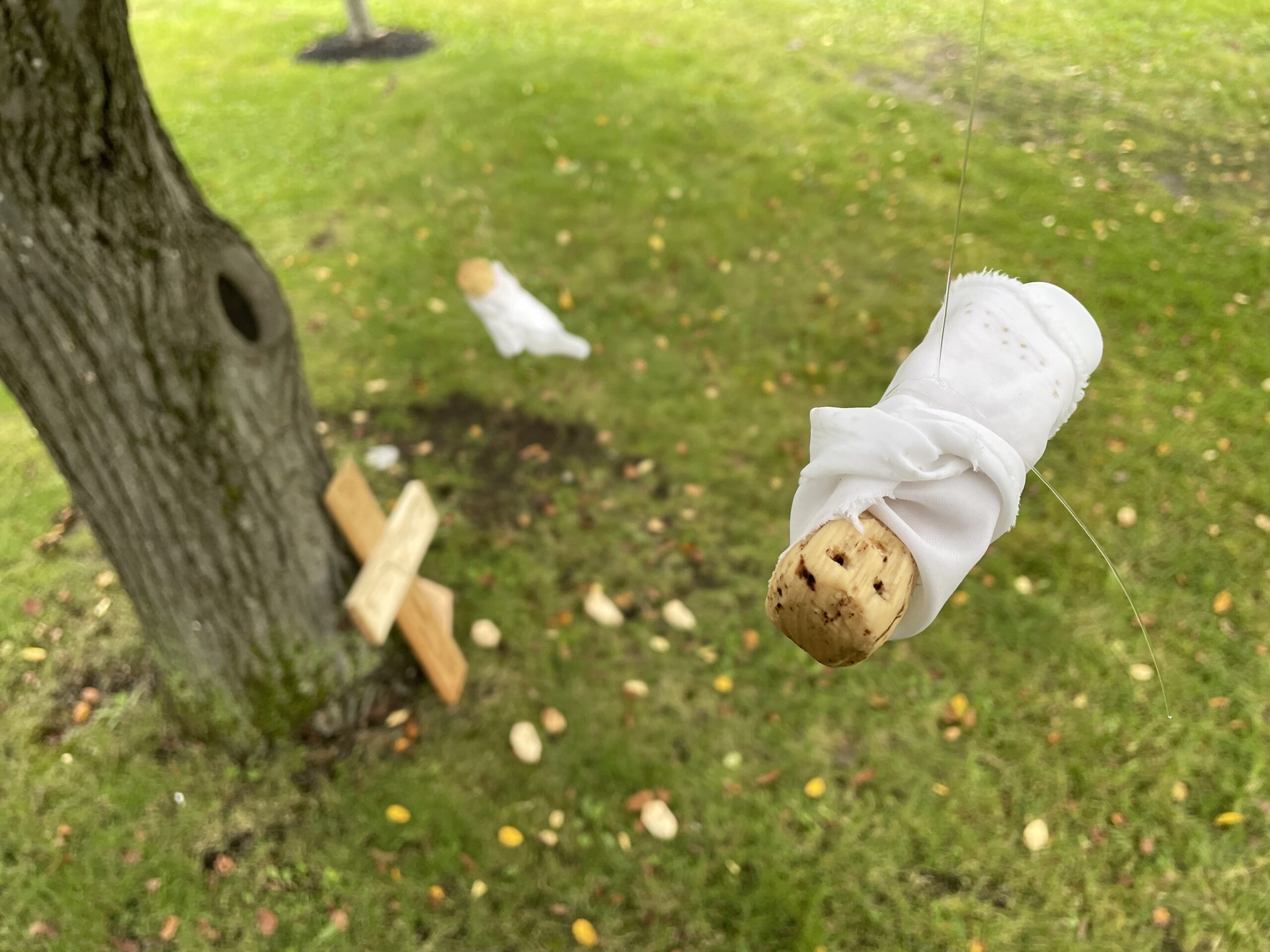Controversial art installation launches campus discussion
September 23, 2022
 Alex Spear
Alex SpearOn Monday morning, an art installation was exhibited on the Chapel lawn facing the Polar Bear statue. The piece sparked controversy, and despite security presence around the piece on Monday, it was vandalized on Tuesday night.
The art piece, a student project for Installation Art, a seminar in the visual arts department, depicts a wooden cross with messages relating to abortion rights. Above the cross reads, “God’s Body God’s Choice,” and engraved into the wood is an image of a uterus captioned “1973-2022.” Infant figurines are suspended around the cross from the tree’s branches, and at the foot of the tree, a small message board which reads “mother’s [sic] who never were” decorated with scattered mini-tombstones of “R.I.P. Mom” with various years etched on each.
Some students found the art’s message confusing.
“I think there’s a place for art and religion and all these things; it was just jarring to me personally,” said Izzy Miller ’23. “It appeared at first like it … was done as an act of threat or hatred … so there was relief when it was clarified that that was not the situation, but I don’t think that undoes the fact that it looked like [it was done by] the street preacher that has come to Bowdoin and harassed students before.”
Other students questioned the artist’s intent, coupled with the reaction her piece garnered from the campus community.
“It’s supposed to be provocative to Bowdoin students to reassess how they feel, but in the same way, that’s so ambiguous … and at the same time, is this really the way to go about it?” said Chloë Raines ’23.
The Orient received a copy of the artist’s statement provided by the original creator of the work, Sophia Rosati ’24, who set up the exhibition as a project for her 3000-level seminar taught by Visiting Assistant Professor of Art Audrey Shakespear. Rosati enumerated her hopes and intentions in creating the artwork, which she described as a “pro-choice piece of art” and a “memorial for the death of Roe v. Wade.”
“The work, much like the title, is a medium for the conjunction of Christian ideology with feminist ideology, representing the inextricable connections between the two,” Rosati wrote in the statement. “Jarring imagery, such as a large cross, babies and gravestones all placed next to the campus’s nondenominational chapel, is used to instill innate shock to the viewer. My goal with this art is to force us to work through that discomfort.”
Rosati’s statement also shed light on her intention of creating an art project with the aim to “deconstruct the common ignorance we share as Bowdoin students.”
“When we encounter things that reach beyond the confines of our Bowdoin bubble, how do we react? How can we interpret something we expect to disagree with, without biases? This piece forces Bowdoin students to look beyond our initial judgments,” Rosati wrote.
According to Rosati, the community’s response has indicated the need for the very dialogue her art strives to create. She mentioned having to file numerous reports of vandalism and theft against her project. The College’s security report documented an instance of the art being “tampered with and vandalized.”
“The response I have seen from campus has just fulfilled the point in my artist’s statement, that it can be incredibly difficult for us all to separate our preconceived notions from our analysis when looking deeper,” Rosati wrote in an email to the Orient. “I appreciate the classes who have discussed my work in depth, however I urge people to continue to digest and accept my artist’s statement and appreciate my art for what it was—art.”
On Tuesday, the class held a discussion section, open to the public, where attendees were able to discuss the impact of the students’ installations. However, few from the public attended.
“I think a lot of harm could have been mitigated by a statement being released immediately,” said Miller. “I think it’s complicated, right? There’s a place for all of this dialogue and I don’t want to come across as someone that’s against art […] But I think it’s really important that we, as a campus community, talk about the fact that the piece, whether or not it was, looked like an act of hatred.”
Comments
Before submitting a comment, please review our comment policy. Some key points from the policy:
- No hate speech, profanity, disrespectful or threatening comments.
- No personal attacks on reporters.
- Comments must be under 200 words.
- You are strongly encouraged to use a real name or identifier ("Class of '92").
- Any comments made with an email address that does not belong to you will get removed.

Sophia Rosati, this is a huge role for art! Well done. You knew it was proactive and I appreciate your statement on the work. It was a brave move and I salute you. Total baddie.